|
Kenya offers a huge diversity of wildlife habitats and much of it is protected in the form of National parks and Reserves. The following summarizes each such location.
Aberdare
National Park 766 sq km (296 sq miles)
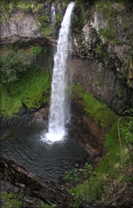 One of Kenya’s oldest protected reserves, the Aberdare National Park was established in
1950 to safeguard the country’s rarest forest ecosystem and its major watershed. Within
its 766 square kilometres are some of Africa’s richest alpine landscapes, with ancient
cedar forests, heather moorlands and bamboo groves divided by icy streams and deep
waterfalls. The Aberdares’ highest peaks, which rise to 13,120 feet, were famous as
a hideout of the Mau Mau freedom fighters in the late 1950s. They contain Kenya’s
tallest waterfall, the 1,000-foot Gura Falls, which together with neighbouring Karura Falls
formed the famous aerial scenes in Out of Africa. The higher slopes, however, should be
avoided during July and August due to thick ‘mountain mist’. One of Kenya’s oldest protected reserves, the Aberdare National Park was established in
1950 to safeguard the country’s rarest forest ecosystem and its major watershed. Within
its 766 square kilometres are some of Africa’s richest alpine landscapes, with ancient
cedar forests, heather moorlands and bamboo groves divided by icy streams and deep
waterfalls. The Aberdares’ highest peaks, which rise to 13,120 feet, were famous as
a hideout of the Mau Mau freedom fighters in the late 1950s. They contain Kenya’s
tallest waterfall, the 1,000-foot Gura Falls, which together with neighbouring Karura Falls
formed the famous aerial scenes in Out of Africa. The higher slopes, however, should be
avoided during July and August due to thick ‘mountain mist’.
The Aberdares provide a
fascinating stopover between Kenya’s northern deserts and its southern parks. The deep
forests are home to a unique range of wildlife, from elephant, lion and giant forest hog to
rare melanistic leopard and serval cats - whose coats have turned black in the rarefied air
- and Kenya’s rarest antelope, the shy chestnut-coated Bongo.
 Top Top
|
Amboseli
National Park 3,920 sq km (1,513 sq miles)
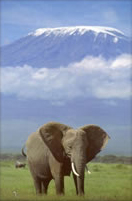 Amboseli National Park, at the foot of Africa’s highest mountain 5895m (19,340ft)
Kilimanjaro is one of the most popular of all Kenya’s national parks. It lies some 240 kms
(145 miles) south-east of Nairobi. The snow-capped peak of Mount Kilimanjaro rising
above a saucer of clouds dominates every aspect of Amboseli National Park which covers
3920 sq km (1513 square miles). The Tanzania border runs along its base and also forms
the boundary of the Park. Years ago this was the locale around which such famous
writers as Ernest Hemingway and Robert Ruark spun their stories of big-game hunting
in the African wilds. Amboseli National Park, at the foot of Africa’s highest mountain 5895m (19,340ft)
Kilimanjaro is one of the most popular of all Kenya’s national parks. It lies some 240 kms
(145 miles) south-east of Nairobi. The snow-capped peak of Mount Kilimanjaro rising
above a saucer of clouds dominates every aspect of Amboseli National Park which covers
3920 sq km (1513 square miles). The Tanzania border runs along its base and also forms
the boundary of the Park. Years ago this was the locale around which such famous
writers as Ernest Hemingway and Robert Ruark spun their stories of big-game hunting
in the African wilds.
It is also the home of the famed Maasai people, those tall, proud
nomadic warriors whose legendary prowess in battle and single handed acts of bravely
in fights with wild animals has spread across the world. Perhaps more than any other
community in Kenya, however, they have learned to live in complete harmony with their
environment and the wildlife which surrounds them. The group which numbers more
than 240,000 have many fascinating traditions which form part of their ages-old culture.
Their diet is a simple one, consisting mainly of meat and milk and also the blood of cattle
- drawn by firing a collared arrow into the beast’s jugular vein - mixed with milk.
The
snows of Kilimanjaro, white and crystalline, also form a backdrop to one of Kenya’s most
spectacular displays of wildlife - lion, elephant, leopard, rhino, cheetah, buffalo and hosts
of plains game and the combination makes the park a photographer’s paradise. Part of
the Park is composed of a dried-up lake bed which in the shimmering heat produces
mirages. Swamps and springs, fed by underground rivers from Kilimanjaro’s melting
snows, form permanent watering places for the wildlife in times of drought.. Many
attractive birds can be easily seen and equally easily photographed around the
lodges. This is one of the few places where the rare and beautiful Taveta Golden
Weaver is found.
 Top Top
|
Lake Baringo 130 sq km (50 sq miles)
Lake Baringo lies in the solitude of the semi-desert of the northern Rift Valley, a
haven of beauty and peace in harsh, rugged, but majestic surroundings. Its beauty
derives as much from the overwhelming sense of being at repose with nature as
much as its scenic splendor.
Until recently, when a new road was completed, the lake was considered ‘off the
beaten track’. Indeed this was explorer’s country. J. W. Gregory, who traveled to the
lake from Mombasa in the last decade of the last century, formulated his theory of
the creation of the Great Rift Valley from evidence found at Baringo. Earlier the slave
caravans passed this way and the remains of Fort Baringo, built to try and stop this
brutal trade, are still visible.
Hippo and crocodile abound but most visitors are entranced by the multitude of birds
- 400 species have been identified and the Goliath heron on a rocky islet (known locally
as Gibraltar Island) is world famous. Bird watching is by boat or by foot and other leisure
activities includes the possibility of a visit to a local Njemps.
 Top Top
|
Lake Bogoria National Reserve 107 sq km (41 sq miles)
In 1892, J W Gregory, the great geologist who first set eyes on Lake Bogoria, described
the sight as “The most beautiful view in Africa”. For decades only the intrepid could
reach the shoreline - by foot, for no roads existed. Travelers to Lake Baringo would pass
within a few miles of the lake hidden behind ridge after ridge of barren stony land but
scarcely anyone was aware of its existence.
Now accessible, but still infinitely remote, the lake presents an exciting contrast to
the more conventional game parks to the south and east.
The lake and the area around
it form a national reserve and although this reserve is primarily scenic it is by no means
devoid of wildlife. Birds are plentiful and at times - especially when the waters of Lake Nakuru are low - it is the haunt of hundreds of thousands of flamingo. On the north
eastern shore greater kudu are to be found as well as a number of plains game.
The journey along the shoreline is made the more exciting by steam jets and boiling
geysers, starkly evidencing the volcanic origins of the Great Rift Valley and reminiscent
of scenes from pre-history.
 Top Top
|
Lake Naivasha 139 sq km (54 sq miles)
The name Naivasha is synonymous with Kenya’s early settler community - and in
particular with the decadent lifestyles of the notorious ‘Happy Valley crowd’. It is an
undeserved reputation, for although a few lives were led to excess here during the
1930's and 40's, Naivasha was primarily a place of wheat farming, cattle breeding and
hard work. Today, much of the old grazing ground has given way to more lucrative
horticulture, but Naivasha remains a pearl for the visitor: a beautiful crystal clear lake,
6,000 feet above sea level, ringed by some of the country’s most charming and luxurious
holiday retreats.
The lake itself is home to hundreds of hippo, and plains game and
cats still roam the game sanctuaries run by several of the lodges and farms. The lake
also boasts one of the greatest diversities of birdlife in the world, with more than
400 species recorded to date.
 Top Top
|
Masai Mara Game Reserve 1,510 sq km (583 sq miles)
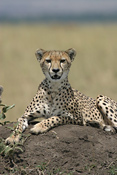 The jewel in Africa’s crown, Masai Mara is host to the most spectacular array of wildlife.
Its vast expanses of open savannah, woodlands and tree-lined rivers creates
an eco-system which supports huge numbers of bird and mammal species. The western
border of the park is the spectacular Siria Escarpment, and together with the acacia dotted
plains, creates scenery of stunning beauty. Lion are found in abundance throughout the
park as are elephant, giraffe, a variety of gazelle species and zebra. Cheetah and leopard
are also regularly seen and, if lucky, you may also find rhino. Game viewing is never dull
in the Mara and patience is often rewarded with unique sightings: a pride of lion stalking
their prey; a solitary leopard retrieving its kill from the high branches of an acacia tree;
male wildebeest sparring to attract females into their harem; or even a herd of elephant
protecting their young from opportunistic predators. The jewel in Africa’s crown, Masai Mara is host to the most spectacular array of wildlife.
Its vast expanses of open savannah, woodlands and tree-lined rivers creates
an eco-system which supports huge numbers of bird and mammal species. The western
border of the park is the spectacular Siria Escarpment, and together with the acacia dotted
plains, creates scenery of stunning beauty. Lion are found in abundance throughout the
park as are elephant, giraffe, a variety of gazelle species and zebra. Cheetah and leopard
are also regularly seen and, if lucky, you may also find rhino. Game viewing is never dull
in the Mara and patience is often rewarded with unique sightings: a pride of lion stalking
their prey; a solitary leopard retrieving its kill from the high branches of an acacia tree;
male wildebeest sparring to attract females into their harem; or even a herd of elephant
protecting their young from opportunistic predators.
The annual wildebeest migration
traditionally is present in the Mara from July to September and at this time, nature’s dramas
unfold before your very eyes at every turn. As well as wildlife, the Masai Mara is also
home to many members of the colourful Maasai tribe who may be seen around the
borders of the park - morans (warriors) loping across the plains, young boys herding
goats, or elders grouped under a tree discussing matters of the day.
 Top Top
|
Meru National Park 870 sq km (336 sq miles)
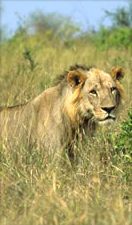 Meru National Park contains a variety of landscapes and wildlife unmatched in any other
Kenyan park of its size. Bordering the arid, open plains that dominate the park are a huge diversity of different ecosystems, ranging from emerald green swamps and towering
indigenous forests in the west to huge palm groves and baobab-studded bush in the east.
This rich slice of equatorial Africa is home to an equally broad variety of wildlife, from
large elephant and buffalo herds to hippo and crocodile, leopard, cheetah and wild dog,
and the lions that remain the park’s most enduring symbol. Meru National Park contains a variety of landscapes and wildlife unmatched in any other
Kenyan park of its size. Bordering the arid, open plains that dominate the park are a huge diversity of different ecosystems, ranging from emerald green swamps and towering
indigenous forests in the west to huge palm groves and baobab-studded bush in the east.
This rich slice of equatorial Africa is home to an equally broad variety of wildlife, from
large elephant and buffalo herds to hippo and crocodile, leopard, cheetah and wild dog,
and the lions that remain the park’s most enduring symbol.
Meru is best known as the inspiration of the film Born Free - the place where
George and Joy Adamson released their famously friendly charges into the bush. The
park’s 870 square kilometers are watered by five major rivers and surrounded by large
protected buffer zones that provide a dispersal area for its animals, which include the
world’s largest herds of Cape buffalo.
 Top Top
|
Mount Kenya National Park 715 sq km (276 sq miles)
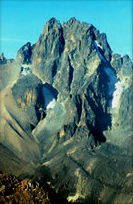 Mount Kenya is the county’s highest mountain.
Sitting astride the equator its icy summit
reaches to 5199m (17058 ft). All of the
mountain above the 3200m (10500 ft)
contour forms a national park. In fact the
mountain consists of three principal zones;
the rocky peak area, actually an eroded
volcanic plug, with its cloak of glaciers
and snow fields; the alpine zone with its
distinctive giant vegetation; and the vast gentle slopes drenched in mountain forest
and bamboo jungle.
It is no wonder that this remote majestic wonderland was considered as God’s
domain by awed farmers at its foothills. Many rivers flow from the perpetual snows,
among them the mighty Tana, source of much of Kenya’s electricity supply. Mount Kenya is the county’s highest mountain.
Sitting astride the equator its icy summit
reaches to 5199m (17058 ft). All of the
mountain above the 3200m (10500 ft)
contour forms a national park. In fact the
mountain consists of three principal zones;
the rocky peak area, actually an eroded
volcanic plug, with its cloak of glaciers
and snow fields; the alpine zone with its
distinctive giant vegetation; and the vast gentle slopes drenched in mountain forest
and bamboo jungle.
It is no wonder that this remote majestic wonderland was considered as God’s
domain by awed farmers at its foothills. Many rivers flow from the perpetual snows,
among them the mighty Tana, source of much of Kenya’s electricity supply.
Most visitors
are content to marvel at the mountain’s beauty but some will want to attempt to reach
the summits; a feat requiring considerable rock-climbing skill. But the mountain’s lesser
peaks and glaciers can all be scaled and walked by the fit and the adventurous. Point
Lenana, 4985 m (16355 ft) can be easily reached.
Wildlife within the forests below the park boundary includes elephant, buffalo, lion,
several species of antelope including the rare bongo and occasionally both melanistic
leopard and serval. Much of this game can be seen from the comfort of Mountain Lodge
which lies just inside the forest on the south side of the mountain.
 Top Top
|
Lake Nakuru National Park 168 sq km (65 sq miles)
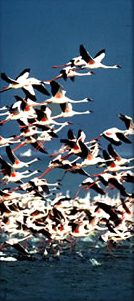 Lake Nakuru, a shallow and alkaline lake on the bed of the Great Rift Valley, has earned
its fame as the home of the greatest bird spectacle in the world - flocks of often more
than a million pink flamingos which seasonally use its waters to feed on the abundant
algae which thrives in its shallow warm waters. It lies 156 kms (100 miles) from Nairobi by road. Although the flamingo are the most obvious, other inhabitants of
the alklaline lake include Black-winged stilts, avocets and in the European winter
a mass of ruffs. Lake Nakuru, a shallow and alkaline lake on the bed of the Great Rift Valley, has earned
its fame as the home of the greatest bird spectacle in the world - flocks of often more
than a million pink flamingos which seasonally use its waters to feed on the abundant
algae which thrives in its shallow warm waters. It lies 156 kms (100 miles) from Nairobi by road. Although the flamingo are the most obvious, other inhabitants of
the alklaline lake include Black-winged stilts, avocets and in the European winter
a mass of ruffs.
Lake Nakuru National Park has a great deal to offer. Beside its magnificent bird life,
it is also a rhino sanctuary and one of the best places in the country to see both black
and white rhino. The park is also host to lion, leopard, buffalo and a variety of plains
and forest game which have made it their permanent and protected habitat. The acacia
savannah which surrounds the lake is itself beautiful and provides an area which is
particularly good for game viewing.
 Top Top
|
Nairobi National
Park 117 sq km (45 sq miles)
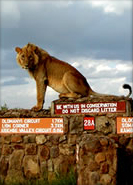 Widely hailed as a model of urban preservation, Nairobi National Park was Kenya’s first
park - and remains one of the world’s greatest city reserves. In this carefully preserved
117-square-kilometre wilderness, it is possible to see rare black rhinos and majestic lions
against the distinctive silhouettes of Nairobi’s modern skyscrapers. Established in 1946,
Nairobi National Park has retained impressive populations of large mammals, including
all the ‘Big Five’ except elephant, and more than 400 bird species. The park is primarily
savannah grassland, with areas of highland forest in the west and riverine forests along
the banks of the Athi River, where hippo and crocodile occupy the river pools. On the
park’s southeastern boundary, the Kitengela Conservation Area provides an important
buffer zone and a natural migration corridor for the many grazing species that move
out of the park with the rainy seasons. Widely hailed as a model of urban preservation, Nairobi National Park was Kenya’s first
park - and remains one of the world’s greatest city reserves. In this carefully preserved
117-square-kilometre wilderness, it is possible to see rare black rhinos and majestic lions
against the distinctive silhouettes of Nairobi’s modern skyscrapers. Established in 1946,
Nairobi National Park has retained impressive populations of large mammals, including
all the ‘Big Five’ except elephant, and more than 400 bird species. The park is primarily
savannah grassland, with areas of highland forest in the west and riverine forests along
the banks of the Athi River, where hippo and crocodile occupy the river pools. On the
park’s southeastern boundary, the Kitengela Conservation Area provides an important
buffer zone and a natural migration corridor for the many grazing species that move
out of the park with the rainy seasons.
 Top Top
|
Samburu National Reserve 104 sq km (40 sq miles)
Samburu National Reserve offers what is arguably Kenya’s greatest - and least changed -
encounter with the wild Africa of yesteryear. This harsh, savagely beautiful wilderness
depends on the steady flow of the Uaso Nyiro River for its existence; the river waters
a wide variety of animal species not found south of the Equator, including the majestic
Beisa oryx, the reticulated giraffe, the thin-striped Grevy’s zebra, and the ‘giraffe-necked’
gerenuk antelope, which stands on its hind legs to feed. Elephant, buffalo, lion and
leopard can all be seen along the river, and the 400-plus species of birds are positively
spectacular.
Together with neighbouring Buffalo Springs and Shaba National Reserves,
Samburu comprises 833 sq km of protected semi-desert land. This is the home of the
Samburu tribe, cousins of the Maasai, who share the same nomadic, cattle-herding
existence, and an even stricter adherence to their age-old rites and customs.
 Top Top
|
Sweetwaters Game Reserve / Ol Pejeta Ranch 97/364 sq km (37/141 sq miles)
The 24,000-acre Sweetwaters Reserve is situated within the sprawling Ol Pejeta ranch
with magnificent views across the plains to the peaks of Mount Kenya. A variety of plains
game is found within the reserve and the big cats may also be seen. As Sweetwaters
is a private reserve, it is possible for visitors to enjoy activities such as escorted bush
walks, night game drives and camel riding.
Orphaned rhino and warthog (one of which
was the model for Pumba, from the movie the Lion King), which have been reared by
hand, provide a wonderful treat for children, as does the chimpanzee sanctuary. The
sanctuary hosts chimps mainly from the Jane Goodall Institute in Burundi, where a
great many were placed after being rescued. The sanctuary is a non-profit venture,
which aims not only to cover the investment and operating costs of the sanctuary,
but also to channel funds into the Jane Goodall Institute for conservation projects for
chimpanzees in the wild throughout Africa.
 Top Top
|
Tsavo East National Park 11,747 sq km (4,535 sq miles)
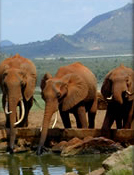 Once one of the world’s greatest elephant and rhino domains, Tsavo East remains
a unique wilderness destination - a land of harsh, arid desert housing a surprisingly rich diversity of life. Together with Tsavo West, this park is one of the world’s largest
protected areas; with the neighbouring Chyulu Hills, the twin Tsavos cover an area of
21,754 square kilometers - more than 450 square kilometres larger than Wales. Once one of the world’s greatest elephant and rhino domains, Tsavo East remains
a unique wilderness destination - a land of harsh, arid desert housing a surprisingly rich diversity of life. Together with Tsavo West, this park is one of the world’s largest
protected areas; with the neighbouring Chyulu Hills, the twin Tsavos cover an area of
21,754 square kilometers - more than 450 square kilometres larger than Wales.
Unlike
Tsavo West, Tsavo East is the epitome of the African bush, with mile upon mile of arid,
thorny scrubland sweeping to the horizon. In these wild surroundings, wildlife viewing
is far more challenging - but often far more rewarding. In little oases along the
Athi, Tiva, Tsavo and Voi rivers, a handful of tented camps offer a remote and very
genuine ‘back to bush’ experience - and some of the wildest, most thrilling walking
safaris anywhere in Africa.
 Top Top
|
Tsavo West National Park 7,065 sq km (2,728 sq miles)
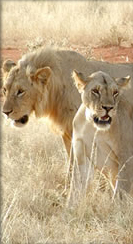 The section of Tsavo National Park south of the Mombasa Road, 9,000-square kilometre
Tsavo West provides a unique step back in
time - to the days when tens of thousands
of giant beasts roamed this forested land.
Today, the forests are gone- the result of
too many elephants and too little rain -
but, thanks to the abundant snowmelt from
Kilimanjaro, the land continues to water a
huge variety of wildlife, from elephant and
buffalo to lion, leopard, oryx, lesser kudu and
klipspringer. Even the dangerously depleted
black rhino are making a minor comeback in a small, fiercely-guarded 70-square-kilometre
sanctuary. The section of Tsavo National Park south of the Mombasa Road, 9,000-square kilometre
Tsavo West provides a unique step back in
time - to the days when tens of thousands
of giant beasts roamed this forested land.
Today, the forests are gone- the result of
too many elephants and too little rain -
but, thanks to the abundant snowmelt from
Kilimanjaro, the land continues to water a
huge variety of wildlife, from elephant and
buffalo to lion, leopard, oryx, lesser kudu and
klipspringer. Even the dangerously depleted
black rhino are making a minor comeback in a small, fiercely-guarded 70-square-kilometre
sanctuary.
Tsavo West’s boundaries encompass a huge variety of habitats, from the lush
forests on the Chyulu Hills to arid desert plains, rich riverine groves to the haunting
lava-flows of Shaitani. The park’s undisputed showpiece is the crystal clear bounty
of Mzima Springs, where in an oasis of raffia palms and fig trees the melting snows
of Kilimanjaro pump over 50 million gallons of water out of the ground each day. An
underwater observation post here offers a novel close encounter with the large crocodile
and pods of hippo that flourish in the cold waters.
 Top Top
|
Information provided with permission of Akorn Destination Management
 Top
Top  Return to Safari
Camps & Map
of Kenya
Return to Safari
Camps & Map
of Kenya
 For
History and General Information about Kenya, click More
Kenya For
History and General Information about Kenya, click More
Kenya
|